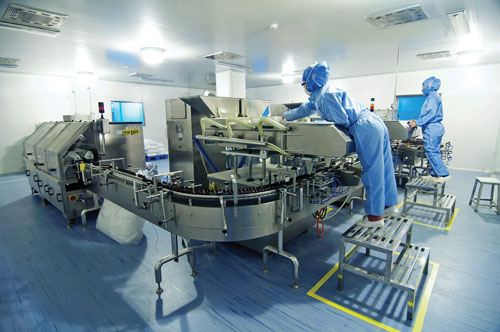March 15, 2016 (Vol. 36, No. 6)
CMOs Are Well Positioned as Early Adopters
The fill-finish market—a traditionally stable one—is increasingly adopting new technologies. Research from our 12th Annual Report and Survey of Biopharmaceutical Manufacturing, and other studies suggests that drug innovators, as well as contract manufacturing organizations (CMOs) are now seeing benefits in terms of capacity usage, production problems, and cost reductions.
As part of a white paper on the changing fill-finish market, we analyzed, by way of a survey of qualified individuals, the capacity utilization that in-house manufacturers currently allocate for fill-finish activities. For in-house fill-finish (excluding CMOs), utilization averaged 55% for lyophilization, 58% for pre-filled devices, and 70% for vialing.

CMOs are often viewed as being best positioned to offer state-of-the-art fill-finish equipment and more secure services than those available through in-house alternatives. [iStock/zhanglianxun]
This suggests that in-house manufacturers have ample levels of capacity for these activities. Yet in a wider annual industry survey we conducted last year, more than 7 in 10 respondents reported outsourcing at least some fill-finish operations. Moreover, the industry appears to be outsourcing more than a small share of these operations.
In fact, respondents estimated outsourcing more than one-third (34.5%) of their fill-finish operations. That was easily the leading result, far ahead of the next-most heavily outsourced activity, analytical testing of bioassays, for which the industry estimated outsourcing slightly more than one-quarter (27.2%) of overall activity.
Those data seem to suggest that outsourcing of fill-finish operations is less related to the level of in-house capacity. This may be due to fill-finish being a traditionally outsourced operation, more so than process development, for example. Yet it may also signal that manufacturers are recognizing the benefits of new technologies, with which CMOs are more likely to have experience.

New Fill-Finish Technologies
As part of our annual study, we examined the fill-finish market in more detail by surveying fill-finish respondents on the trends in their industry. We found that almost eight in ten respondents—the majority of whom worked for contract manufacturing organizations— were planning to add at least one new fill-finish technology to their operations in the next two years.
The most commonly cited technologies were single-use fill-finish devices and automation, each by more than one-third (36.4%) of respondents. Separately, respondents overwhelmingly pointed to single-use/disposable equipment adoption as the most important trend today in fill-finish, with three-quarters of respondents citing this trend. (The next-most cited trend, facilities becoming more multiproduct-use oriented, was indicated as an important trend by fewer than half of the respondents.)
With single-use equipment becoming increasingly important in the fill-finish market, perhaps it’s not too much of a surprise that CMOs figure prominently in these activities. After all, our research has consistently shown that CMOs have been on the leading edge of new technology adoption, particularly as it pertains to single-use devices. For example, in our industry study, we found disposables adoption to be broader among CMOs than biotherapeutic developers for 13 of the 15 products we tracked.

Conclusion
There are certainly a variety of reasons for which biotherapeutic developers consider outsourcing fill-finish activities. However, with biologics—and by extension fill-finish —more valuable operations, there appears to be an expectation that CMOs offer state-of-the-art fill-finish equipment and more secure services than may be available through in-house alternatives. CMOs, already on the leading edge of single-use adoption, are well-positioned to benefit from these growing expectations and changes in the fill-finish segment.
Eric S. Langer ([email protected]) is president and managing partner
at BioPlan Associates.



